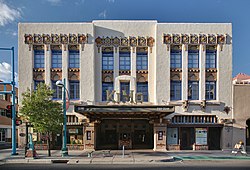KiMo Theater
|
Kimo Theatre
|
|
 |
|
| Location | 423 Central Avenue NW, Albuquerque, New Mexico |
|---|---|
| Coordinates | 35°5′5.99″N 106°39′7.11″W / 35.0849972°N 106.6519750°WCoordinates: 35°5′5.99″N 106°39′7.11″W / 35.0849972°N 106.6519750°W |
| Built | 1927 |
| Architect | Boller Brothers; Carl Boller |
| Architectural style | Pueblo Deco |
| NRHP Reference # | 77000920 |
| NMSRCP # | 453 |
| Significant dates | |
| Added to NRHP | May 2, 1977 |
| Designated NMSRCP | July 30, 1976 |
The KiMo Theatre is a theatre located at 423 Central Avenue NW in downtown Albuquerque, New Mexico and it is probably the city's best-known landmark. It was built in 1927 in the extravagant Art Deco-Pueblo Revival Style architecture, which is a blend of adobe building styles (rounded corners and edges), decorative motifs from indigenous cultures, and the soaring lines and linear repetition found in American Art Deco architecture.
The KiMo was conceived by entrepreneur Oreste Bachechi and designed for him by Carl Boller of the Boller Brothers architecture firm, who conducted an extensive investigation into the cultures and building styles of the Southwest before submitting his design. The theater is a three-story stucco building with the stepped massing characteristic of native pueblo architecture, as well as the recessed spandrels and strong vertical thrust of Art Deco skyscrapers. Both the exterior and interior of the building incorporate a variety of indigenous motifs, like the row of terra cotta shields above the third-floor windows.
The name "KiMo" (literally translated as "mountain lion" in Tewa, and sometimes loosely translated as "king of its kind") was supplied by Isleta Pueblo Governor Pablo Abeita, who won $50 for his suggestion.
By 1977, the theater had fallen into disrepair but was saved from the wrecking ball when voters approved a plan for the City of Albuquerque to purchase the structure. It has undergone several phases of continuing restoration to return it to its former glory and is once again open to the public for performances. The most recent preservation was completed in 2000 with the installation of new seating and carpet, main stage curtain, new tech booth, lighting positions hid between and behind "vigas" on the ceiling, and a re-creation of the KiMo's original proscenium arch. The auditorium seating capacity was 650 at completion of the restoration.
...
Wikipedia
